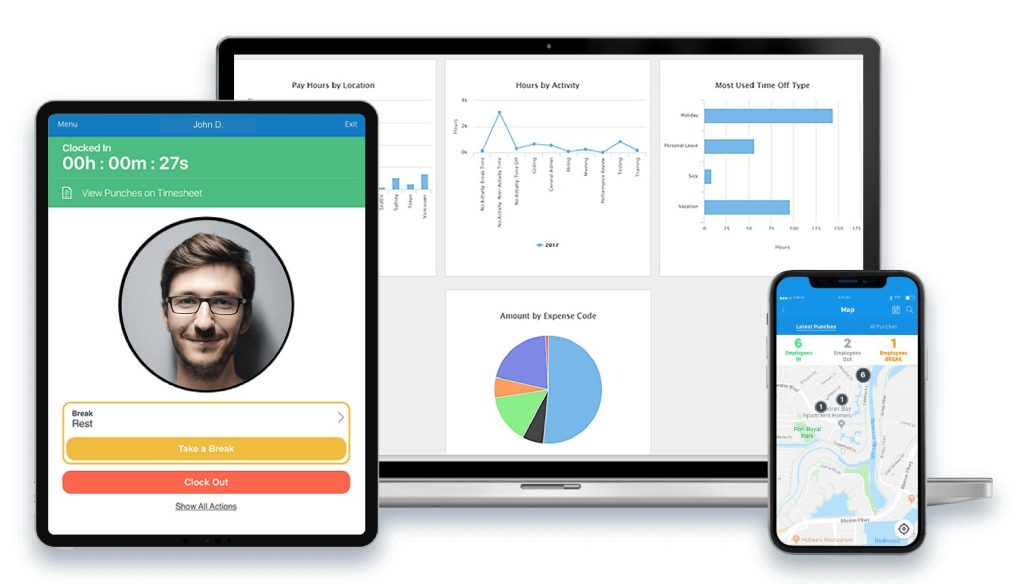Remote workforce management presents significant operational challenges for modern organizations, particularly in tracking employee time and attendance across different locations and time zones. The implementation of digital attendance systems has become necessary for maintaining operational efficiency and ensuring accurate workforce management.
For organizations transitioning to remote work models, understanding the systematic approach to implementing mobile attendance solutions is essential for successful workforce management and regulatory compliance.
Why a Mobile Time and Attendance App is Ideal for Remote Teams
With a mobile time and attendance app, your team can log their work hours from anywhere with just a few taps on their phone. These apps allow employees to clock in, clock out, and take breaks without needing to be physically present at an office. For managers, the app provides a clear view of who’s working, when they started, and how many hours they’ve put in—all in real-time.
Using this technology can simplify payroll, reduce mistakes, and make scheduling easier. It also helps remote employees feel more connected and responsible for their work hours.
What Are the Requirements for Remote Time Tracking Systems?
The digital transformation of workforce management demands robust time-tracking solutions that can adapt to diverse remote working conditions. Mobile time and attendance systems must integrate seamlessly with existing organizational processes while providing accurate, reliable data for payroll processing and performance management. Here are the essential features for optimal implementation:
User Interface and Accessibility
A mobile time and attendance app must prioritize intuitive design and accessibility. The system should provide clear visual indicators for clock-in/clock-out status, work hours tracking, and schedule management. Employees should be able to navigate the interface effortlessly, reducing training time and increasing adoption rates.
The interface must accommodate various device types and operating systems while maintaining consistent functionality across platforms.
Geographic Verification Systems
Location tracking capabilities represent a crucial component of remote attendance systems. Advanced GPS integration enables accurate location verification while geofencing technology establishes virtual boundaries for legitimate work locations.
This technology must balance accuracy with privacy concerns, implementing appropriate data protection measures while maintaining reliable tracking capabilities.
Time Management Functionality
Comprehensive time management features form the backbone of effective attendance tracking. The system must support flexible schedule management, break time monitoring, and overtime tracking. Additionally, integration with leave management systems ensures seamless handling of time-off requests and attendance policy compliance.
How Should Organizations Prepare for Implementation?
Successful implementation of mobile attendance systems requires careful planning and systematic execution. The preparation phase establishes the foundation for system adoption and long-term success. Organizations must consider technical requirements, user training needs, and policy adjustments to ensure smooth transition and optimal utilization.
Here are essential preparation steps for successful implementation:
- Conduct thorough system requirement analysis
- Develop a comprehensive implementation timeline
- Create detailed training materials
- Establish clear communication channels
- Define success metrics and monitoring protocols
These preparatory measures ensure systematic implementation while minimizing disruption to existing operations and maximizing user adoption rates.
What Are the Best Practices for System Deployment?
Effective system deployment requires understanding user needs and optimizing functionality for seamless adoption. Organizations should foster a supportive environment, as successful deployment directly impacts the long-term efficacy of a mobile attendance solution. Here are the essential strategies:
Training and Support Systems
Effective training programs ensure successful system adoption. Organizations must develop comprehensive training materials, conduct regular sessions, and provide ongoing support resources. The training approach should accommodate different learning styles and technical proficiency levels while maintaining consistent messaging about system benefits and usage protocols.
Policy Integration
Clear attendance policies must align with the new system’s capabilities. Organizations should review and update existing policies to reflect the digital tracking environment while ensuring compliance with labor regulations and company standards. Policy communication must be clear and accessible to all team members.
What Challenges Should Organizations Anticipate?
Implementation challenges require proactive identification and strategic resolution approaches. Organizations must prepare for various technical and operational obstacles while maintaining focus on long-term objectives and user needs.
Common implementation challenges include:
- Technical integration issues
- User resistance to change
- Time zone coordination
- Data accuracy verification
- Privacy concerns
Understanding these challenges enables organizations to develop effective mitigation strategies and maintain implementation momentum.
Conclusion
Mobile time and attendance solutions represent essential tools for modern workforce management. Successful implementation requires careful planning, systematic execution, and ongoing support. Organizations must focus on user needs while maintaining operational efficiency and data accuracy. Through proper preparation and strategic deployment, organizations can achieve successful adoption and realize the full benefits of mobile attendance tracking systems.
Guest writer.



























